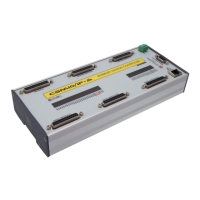www.cs-lab.eu
CS-Lab s.c. | CSMIO/IP-A 6-axis CNC controller. Manual tunning
1. Before you start
Since you are reading this guide, you have probably already tried to use the auto-tuning feature, but it was
unsuccessful, or the effects were unsatisfactory, and you want to try manual tuning now.
You must be aware that manual tuning can also end up in the same way. The auto-tuning function stops its
operation or gives unsatisfactory results only when even an experienced technician could have serious prob-
lems. Both the auto-tuning feature and the qualified technician have certain tolerance limits beyond which
they cannot guarantee that the tuning will be successful.
In this situation, should we immediately reach for the option of manual tuning and persistently look for the
value of PID regulator parameters, at which the machine will be somehow usable? Well no. First, we should
verify why the auto-tuning has not fulfilled its task. In most cases, the reason is:
- deregulated PID current or velocity loop regulator of a servo drive,
- a bad condition of servo magnets,
- fault in the control signal +/- 10V connection
- originally low sensitivity and sluggishness of a servo drive,
- substantial interference caused by incorrect connection of a servo drive,
- too strong filters of the set or actual speed of a servo drive.
The test, which consists in connecting a manual voltage generator (9V battery + potentiometer) or a labora-
tory power supply to a +/- 10V input of a servo drive to perform a manual axis run, only proves that the servo
drive is working, but does not prove its good condition, nor the correct tuning of PID regulators. We mention
this because many users find this test as a confirmation that their servo drive is perfect in every way and
does not require any maintenance.
To determine if the servo drive is in good condition and adequately tuned, compare two values presented
preferably as overlapping waveforms. We are talking about the value of the set speed and the actual rate of
a servo shaft. In the case of newer servo drives, this will be possible using a dedicated diagnostic utility for
the servo drive. In the case of older servo drives, using an oscilloscope and test points indicated on the servo
PCB by a manufacturer in a product manual.

